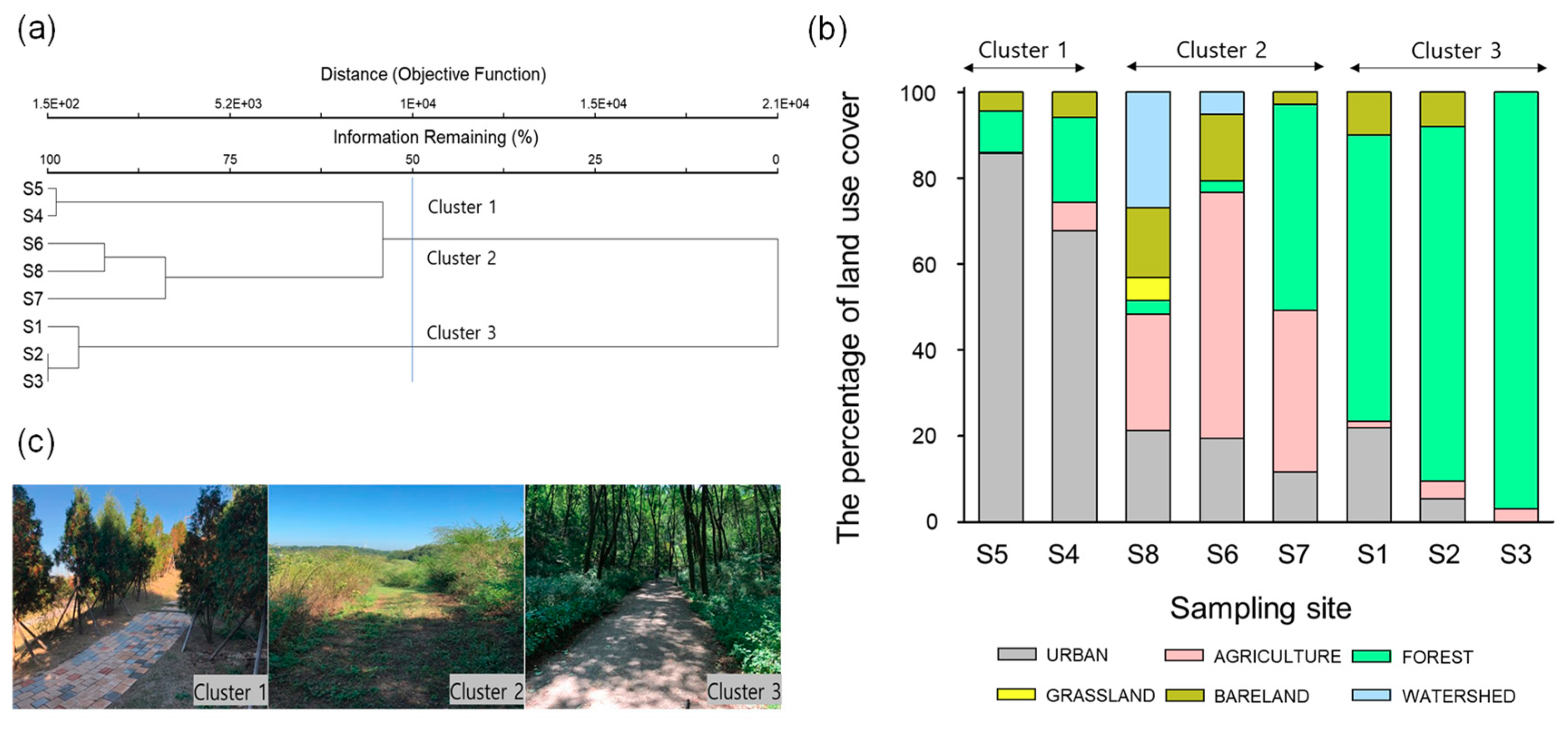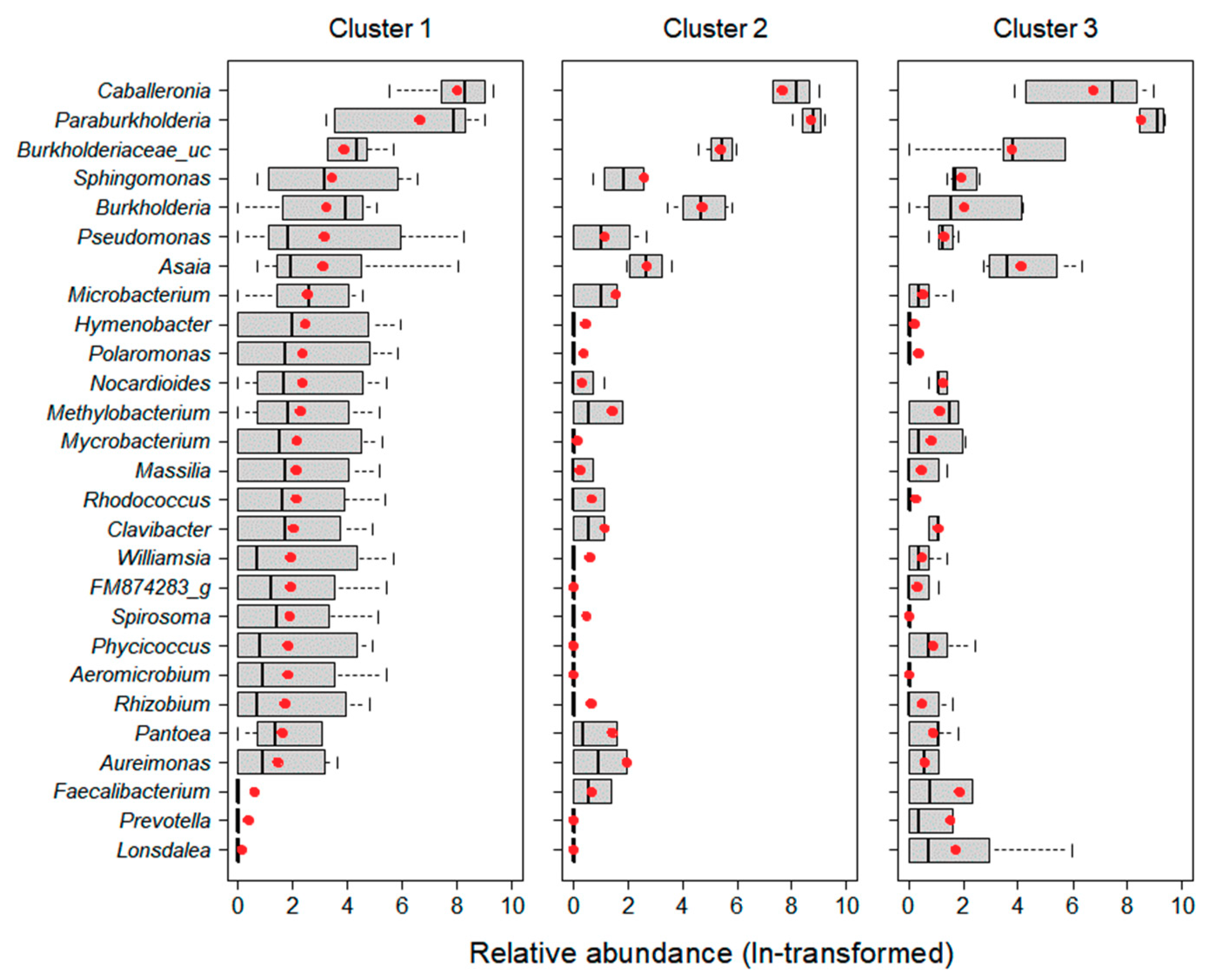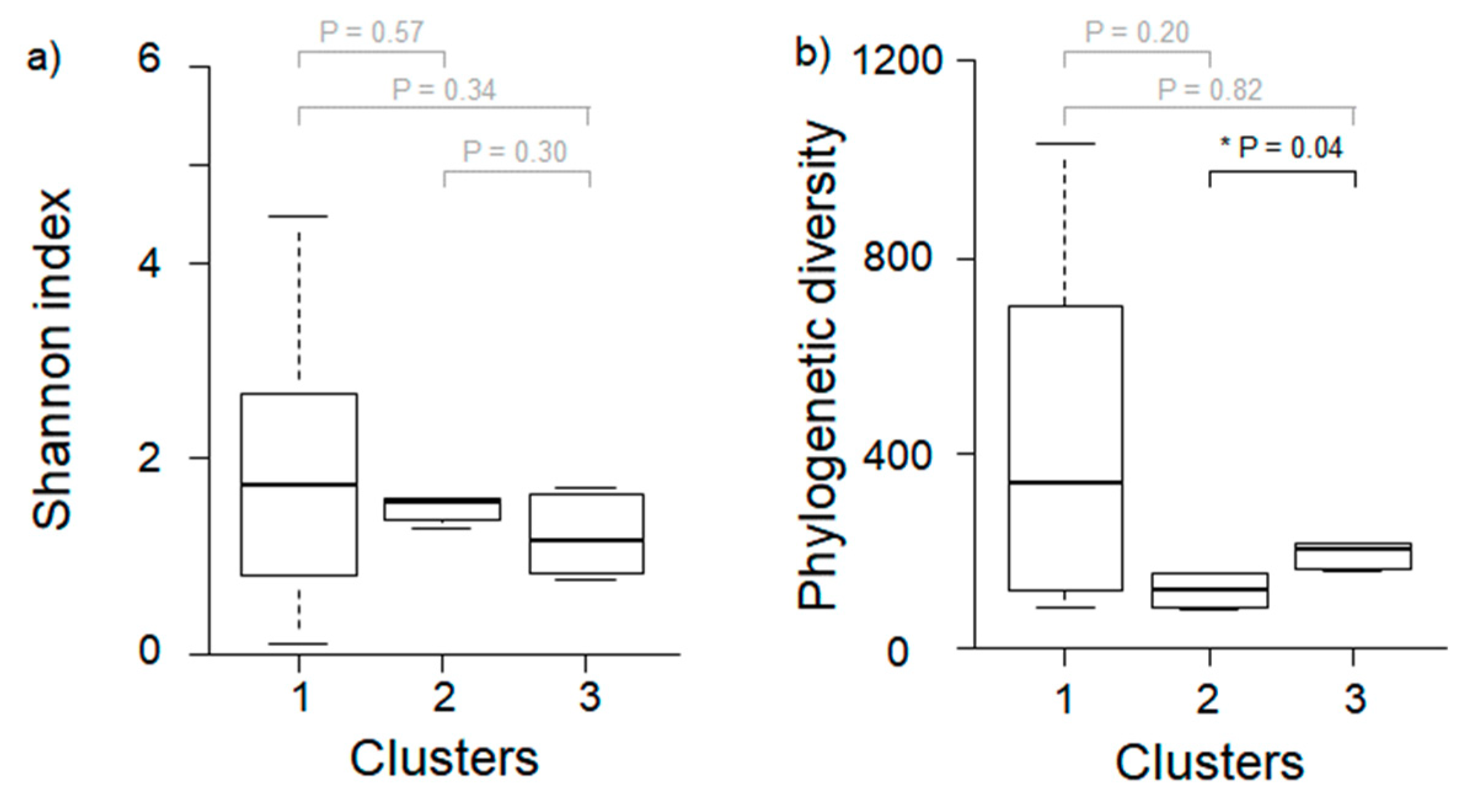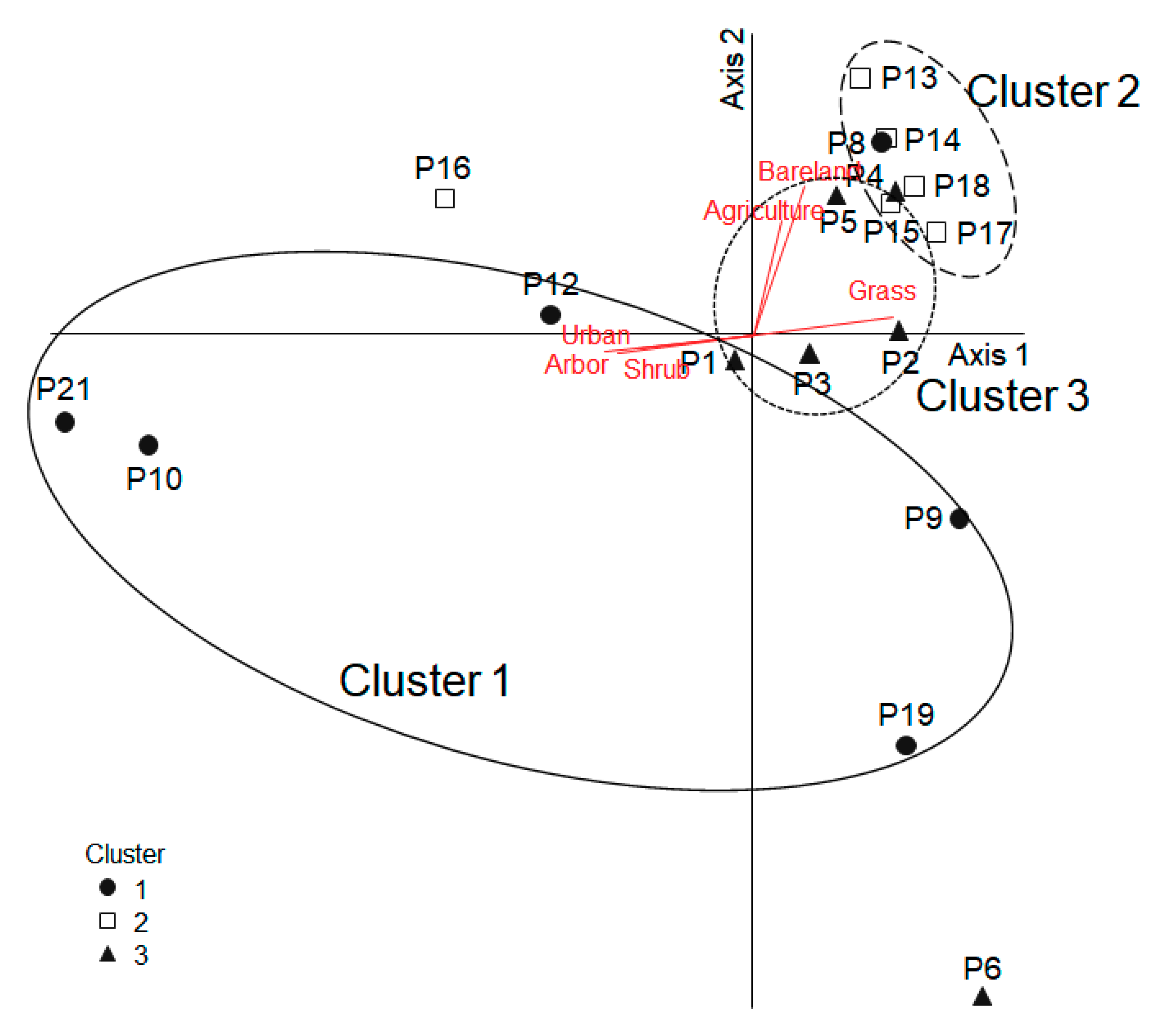Characteristics of Microbial Communities of Pachygrontha antennata (Hemiptera: Pachygronthidae) in Relation to Habitat Variables
Abstract
1. Introduction
2. Materials and Methods
2.1. Microbial Community
2.2. Habitat Variables
2.3. Data Analysis
2.3.1. Multivariate Analyses
2.3.2. Statistical Analyses
3. Results
3.1. Characteristics of Macro and Microhabitat Variables
3.2. Classification of Macrohabitat Type
3.3. Difference in Microbial Communities
3.4. Ordination with Microbial Community
4. Discussion
5. Conclusions
Author Contributions
Funding
Acknowledgments
Conflicts of Interest
References
- Dethlefsen, L.; McFall-Ngai, M.; Relman, D.A. An ecological and evolutionary perspective on human–microbe mutualism and disease. Nature 2007, 449, 811–818. [Google Scholar] [CrossRef]
- Forsythe, P.; Sudo, N.; Dinan, T.; Taylor, V.H.; Bienenstock, J. Mood and gut feelings. Brain Behav. Immun. 2010, 24, 9–16. [Google Scholar] [CrossRef] [PubMed]
- Sekirov, I.; Russell, S.L.; Antunes, L.C.M.; Finlay, B.B. Gut microbiota in health and disease. Physiol. Rev. 2010, 90, 859–904. [Google Scholar] [CrossRef] [PubMed]
- Hooper, L.V.; Littman, D.R.; Macpherson, A.J. Interactions between the microbiota and the immune system. Science 2012, 336, 1268–1273. [Google Scholar] [CrossRef] [PubMed]
- Amato, K.R. Co-evolution in context: The importance of studying gut microbiomes in wild animals. Microbiome Sci. Med. 2013, 1, 10–29. [Google Scholar] [CrossRef]
- Shapira, M. Gut microbiotas and host evolution: Scaling up symbiosis. Trends Ecol. Evol. (Amst.) 2016, 31, 539–549. [Google Scholar] [CrossRef]
- Tiede, J.; Scherber, C.; Mutschler, J.; McMahon, K.D.; Gratton, C. Gut microbiomes of mobile predators vary with landscape context and species identity. Ecol. Evol. 2017, 7, 8545–8557. [Google Scholar] [CrossRef]
- Teyssier, A.; Rouffaer, L.O.; Saleh Hudin, N.S.; Strubbe, D.; Matthysen, E.; Lens, L.; White, J. Inside the guts of the city: Urban-induced alterations of the gut microbiota in a wild passerine. Sci. Total Environ. 2018, 612, 1276–1286. [Google Scholar] [CrossRef]
- Savage, A.M.; Hackett, B.; Guénard, B.; Youngsteadt, E.K.; Dunn, R.R. Fine-scale heterogeneity across Manhattan’s urban habitat mosaic is associated with variation in ant composition and richness. Insect Conserv. Divers. 2015, 8, 216–228. [Google Scholar] [CrossRef]
- Engel, P.; Moran, N.A. The gut microbiota of insects - diversity in structure and function. FEMS Microbiol. Rev. 2013, 37, 699–735. [Google Scholar] [CrossRef]
- Schwab, A.; Dubois, D.; Fried, P.M.; Edwards, P.J. Estimating the biodiversity of hay meadows in north-eastern Switzerland on the basis of vegetation structure. Agric. Ecosyst. Environ. 2002, 93, 197–209. [Google Scholar] [CrossRef]
- Bröring, U.; Wiegleb, G. Soil zoology II: Colonization, distribution, and abundance of terrestrial Heteroptera in open landscapes of former brown coal mining areas. Ecol. Eng. 2005, 24, 135–147. [Google Scholar] [CrossRef]
- Frank, T.H.; Kunzle, I.R. Effect of early succession in wildflower areas on bug assemblages (Insecta: Heteroptera). Eur. J. Entomol. 2006, 103, 61–70. [Google Scholar] [CrossRef]
- Galle, R.; Torma, A.; Körmöczi, L. Small-scale effect of habitat heterogeneity on invertebrate assemblages in sandy grasslands (Hungarian Great Plain). Pol. J. Ecol. 2010, 58, 333–346. [Google Scholar]
- Torma, A.; Varga, C.; Varga, M. Spatial pattern of true bugs (Heteroptera) in heterogeneous grassland—preliminary results. Acta Phytopathol. Entomol. Hung. 2010, 45, 81–87. [Google Scholar] [CrossRef]
- Torma, A.; Császár, P. Species richness and composition patterns across trophic levels of true bugs (Heteroptera) in the agricultural landscape of the lower reach of the Tisza River Basin. J. Insect Conserv. 2013, 17, 35–51. [Google Scholar] [CrossRef]
- Brändle, M.; Amarell, U.; Auge, H.; Klotz, S.; Brandl, R. Plant and insect diversity along a pollution gradient: Understanding species richness across trophic levels. Biodivers. Conserv. 2001, 10, 1497–1511. [Google Scholar] [CrossRef]
- Henry, T.J. Phylogenetic analysis of family groups within the infraorder Pentatomomorpha (Hemiptera: Heteroptera), with emphasis on the Lygaeoidea. Ann. Entomol. Soc. Am. 1997, 90, 275–301. [Google Scholar] [CrossRef]
- Ahn, S.J. Hemiptera of Korea; Nature and Ecology Publishing Company: Seoul, Korea, 2010; p. 52. [Google Scholar]
- Audsley, M.D.; Seleznev, A.; Joubert, D.A.; Woolfit, M.; O’Neill, S.L.; McGraw, E.A. Wolbachia infection alters the relative abundance of resident bacteria in adult Aedes aegypti mosquitoes, but not larvae. Mol. Ecol. 2018, 27, 297–309. [Google Scholar] [CrossRef]
- Kikuchi, Y.; Hosokawa, T.; Fukatsu, T. An ancient but promiscuous host–symbiont association between Burkholderia gut symbionts and their heteropteran hosts. ISME J. 2011, 5, 446. [Google Scholar] [CrossRef]
- Phillips, J.N.; Berlow, M.; Derryberry, E.P. The effects of landscape urbanization on the gut microbiome: An exploration into the gut of urban and rural white-crowned sparrows. Front. Ecol. Evol. 2018, 6, 148. [Google Scholar] [CrossRef]
- Crotti, E.; Balloi, A.; Hamdi, C.; Sansonno, L.; Marzorati, M.; Gonella, E.; Favia, G.; Cherif, A.; Bandi, C.; Alma, A.; et al. Microbial symbionts: A resource for the management of insect-related problems. Microb. Biotechnol. 2012, 5, 307–317. [Google Scholar] [CrossRef] [PubMed]
- Crotti, E.; Sansonno, L.; Prosdocimi, E.M.; Vacchini, V.; Hamdi, C.; Cherif, A.; Gonella, E.; Marzorati, M.; Balloi, A. Microbial symbionts of honeybees: A promising tool to improve honeybee health. New Biotechnol. 2013, 30, 716–722. [Google Scholar] [CrossRef] [PubMed]
- Berasategui, A.; Shukla, S.; Salem, H.; Kaltenpoth, M. Potential applications of insect symbionts in biotechnology. Appl. Microbiol. Biotechnol. 2016, 100, 1567–1577. [Google Scholar] [CrossRef] [PubMed]
- Kautz, S.; Rubin, B.E.; Russell, J.A.; Moreau, C.S. Surveying the microbiome of ants: Comparing 454 Pyrosequencing with traditional methods to uncover bacterial diversity. Appl. Environ. Microbiol. 2013, 79, 525–534. [Google Scholar] [CrossRef] [PubMed]
- Rubin, B.E.; Sanders, J.G.; Hampton-Marcell, J.; Owens, S.M.; Gilbert, J.A.; Moreau, C.S. DNA extraction protocols cause differences in 16S rRNA amplicon sequencing efficiency but not in community profile composition or structure. Microbiol. Open 2014, 3, 910–921. [Google Scholar] [CrossRef]
- Fadrosh, D.W.; Ma, B.; Gajer, P.; Sengamalay, N.; Ott, S.; Brotman, R.M.; Ravel, J. An improved dual-indexing approach for multiplexed 16S rRNA gene sequencing on the Illumina MiSeq platform. Microbiome 2014, 2, 6. [Google Scholar] [CrossRef]
- Yoon, S.H.; Ha, S.M.; Kwon, S.; Lim, J.; Kim, Y.; Seo, H.; Chun, J. Introducing EzBioCloud: A taxonomically united database of 16S rRNA gene sequences and whole-genome assemblies. Int. J. Syst. Evol. Microbiol. 2017, 67, 1613–1617. [Google Scholar] [CrossRef]
- Calle, M.L. Statistical analysis of metagenomics data. Genom. Inform. 2019, 17. [Google Scholar] [CrossRef]
- USDA (United States Department of Agriculture) Forest Service. Forest Inventory and Analysis National Program-Field Methods for Forest Health (Phase 3) Measurements ver 3.0. October 2005. Available online: https://www.fia.fs.fed.us/library/field-guides-methods-proc/index.php (accessed on 10 April 2018).
- Kőrösi, Á.; Batáry, P.; Orosz, A.; Rédei, D.; Báldi, A. Effects of grazing, vegetation structure and landscape complexity on grassland leafhoppers (Hemiptera: Auchenorrhyncha) and true bugs (Hemiptera: Heteroptera) in Hungary. Insect Conserv. Divers. 2012, 5, 57–66. [Google Scholar] [CrossRef]
- Rossetti, M.R.; Rösch, V.; Videla, M.; Tscharntke, T.; Batáry, P. Insect and plant traits drive local and landscape effects on herbivory in grassland fragments. Ecosphere 2019, 10, e02717. [Google Scholar] [CrossRef]
- Mielke, P.W., Jr.; Berry, K.J.; Johnson, E.S. Multi-response permutation procedures for a priori classifications. Commun. Stat. Theor. Methods 1976, 5, 1409–1424. [Google Scholar] [CrossRef]
- Palavesam, A.; Guerrero, F.D.; Heekin, A.M.; Wang, J.; Dowd, S.E.; Sun, Y.; Foil, L.D.; Pérez de León, A.A.P. Pyrosequencing-based analysis of the microbiome associated with the horn fly, Haematobia irritans. PLoS ONE 2012, 7, e44390. [Google Scholar] [CrossRef] [PubMed]
- McCune, B.; Mefford, M.J. PC-ORD: Multivariate analysis of ecological data. MjM software design. 4th Version for Windows; [User’s Guide]; MjM software: Oregon, OR, USA, 1999. [Google Scholar]
- Niemelä, J. Is there a need for a theory of urban ecology? Urban Ecosyst. 1999, 3, 57–65. [Google Scholar] [CrossRef]
- Meillère, A.; Brischoux, F.; Henry, P.Y.; Michaud, B.; Garcin, R.; Angelier, F. Growing in a city: Consequences on body size and plumage quality in an urban dweller, the house sparrow (Passer domesticus). Lands. Urban. Plan. 2017, 160, 127–138. [Google Scholar] [CrossRef]
- Lowe, E.C.; Threlfall, C.G.; Wilder, S.M.; Hochuli, D.F. Environmental drivers of spider community composition at multiple scales along an urban gradient. Biodivers. Conserv. 2018, 27, 829–852. [Google Scholar] [CrossRef]
- Sawana, A.; Adeolu, M.; Gupta, R.S. Molecular signatures and phylogenomic analysis of the genus Burkholderia: Proposal for division of this genus into the emended genus Burkholderia containing pathogenic organisms and a new genus Paraburkholderia gen. nov. harboring environmental species. Front. Genet. 2014, 5, 429. [Google Scholar] [CrossRef]
- Dobritsa, A.P.; Samadpour, M. Transfer of eleven species of the genus Burkholderia to the genus Paraburkholderia and proposal of Caballeronia gen. nov. to accommodate twelve species of the genera Burkholderia and Paraburkholderia. Int. J. Syst. Evol. Microbiol. 2016, 66, 2836–2846. [Google Scholar] [CrossRef]
- Rahman, M.; Sabir, A.A.; Mukta, J.A.; Khan, M.M.A.; Mohi-Ud-Din, M.; Miah, M.G.; Rahman, M.; Islam, M.T. Plant probiotic bacteria Bacillus and Paraburkholderia improve growth, yield and content of antioxidants in strawberry fruit. Sci. Rep. 2018, 8, 2504. [Google Scholar] [CrossRef]
- Tago, K.; Okubo, T.; Itoh, H.; Kikuchi, Y.; Hori, T.; Sato, Y.; Nagayama, A.; Hayashi, K.; Ikeda, S.; Hayatsu, M. Insecticide-degrading Burkholderia symbionts of the stinkbug naturally occupy various environments of sugarcane fields in a Southeast island of Japan. Microbes Environ. 2015, 30, 29–36. [Google Scholar] [CrossRef]
- Kikuchi, Y.; Hayatsu, M.; Hosokawa, T.; Nagayama, A.; Tago, K.; Fukatsu, T. Symbiont-mediated insecticide resistance. Proc. Natl. Acad. Sci. USA 2012, 109, 8618–8622. [Google Scholar] [CrossRef] [PubMed]
- Yun, J.H.; Roh, S.W.; Whon, T.W.; Jung, M.J.; Kim, M.S.; Park, D.S.; Yoon, C.; Nam, Y.D.; Kim, Y.J.; Choi, J.H.; et al. Insect gut bacterial diversity determined by environmental habitat, diet, developmental stage, and phylogeny of host. Appl. Environ. Microbiol. 2014, 80, 5254–5264. [Google Scholar] [CrossRef] [PubMed]
- Zhang, Y.C.; Cao, W.J.; Zhong, L.R.; Godfray, H.C.J.; Liu, X.D. Host plant determines the population size of an obligate symbiont (Buchnera aphidicola) in aphids. Appl. Environ. Microbiol. 2016, 82, 2336–2346. [Google Scholar] [CrossRef] [PubMed]
- Jones, J.C.; Fruciano, C.; Hildebrand, F.; Al Toufalilia, H.; Balfour, N.J.; Bork, P.; Engel, P.; Ratnieks, F.L.W.; Hughes, W.O. Gut microbiota composition is associated with environmental landscape in honey bees. Ecol. Evol. 2018, 8, 441–451. [Google Scholar] [CrossRef] [PubMed]
- Rajagopal, T.; Singam, P.; Kulandaivel, S.; Selvarani, S.; Sevarkodiyone, S.; Ponmanickam, P. The red weaver ant, Oecophylla smaragdina as vectors of bacteria in urban environments. Int. J. Entomol. Res. 2019, 4, 46–49. [Google Scholar]
- Schneider, M.; Dorn, A. Differential infectivity of two Pseudomonas species and the immune response in the milkweed bug, Oncopeltus fasciatus (Insecta: Hemiptera). J. Invertebr. Pathol. 2001, 78, 135–140. [Google Scholar] [CrossRef] [PubMed]





| Site | Region | Coordination | Samples | |
|---|---|---|---|---|
| Latitude | Longitude | |||
| S1 | Daejeon | 36.37441 | 127.3486 | P1, P2, P3 |
| S2 | Daejeon | 36.11464 | 127.3297 | P4, P5 |
| S3 | Daejeon | 36.30056 | 126.9169 | P6 |
| S4 | Buyeo | 36.28120 | 126.9169 | P8, P9, P19 |
| S5 | Seoul | 37.51008 | 127.0767 | P10, P12, P21 |
| S6 | Buyeo | 36.26959 | 126.9122 | P13, P14, P15 |
| S7 | Seocheon | 36.02857 | 126.7268 | P16, P17 |
| S8 | Gunsan | 36.00767 | 126.7569 | P18 |
| Category | Variables | Abbreviation | Mean (± SD) | |
|---|---|---|---|---|
| Microhabitat variable (10 × 10 m) | Ambient temperature | Average daily temperature (°C) | Temp_ave | 24.8 ± 2.2 |
| Maximum daily temperature (°C) | Temp_max | 32.0 ± 3.6 | ||
| Minimum daily temperature (°C) | Temp_min | 18.7 ± 1.7 | ||
| Cover degree | Grass (%) | Grass | 59.1 ± 36.1 | |
| Arbor (%) | Arbor | 19.7 ± 18.7 | ||
| Shrub (%) | Shrub | 21.2 ± 19.5 | ||
| Canopy (%) | Canopy | 27.8 ± 18.8 | ||
| Macrohabitat variable (500 m radius) | Land use | Urban area (%) | Urban | 35.6 ± 31.1 |
| Agriculture area (%) | Agriculture | 17.2 ± 22.0 | ||
| Forest area (%) | Forest | 36.5 ± 32.9 | ||
| Grassland (%) | Grassland | 0.3 ± 1.3 | ||
| Bare land (%) | Bareland | 8.0 ± 4.9 | ||
| Watershed area (%) | Watershed | 2.4 ± 6.4 | ||
| Land Use | Cover Degree | Ambient Temperature | |||||
|---|---|---|---|---|---|---|---|
| Grass | Arbor | Shrub | Canopy | Temp_ave | Temp_max | Temp_min | |
| Urban | −0.43 | 0.57 * | 0.25 | 0.37 | 0.46 | 0.27 | 0.72 ** |
| Agriculture | 0.51 * | −0.48 * | −0.50 * | −0.85 ** | 0.30 | 0.48 * | −0.19 |
| Forest | 0.07 | −0.16 | 0.06 | 0.35 | −0.66 ** | −0.81 ** | −0.63 ** |
| Grassland | 0.31 | −0.31 | −0.31 | −0.36 | −0.02 | 0.12 | 0.12 |
| Bare land | 0.27 | −0.30 | −0.28 | −0.17 | 0.21 | 0.45 | −0.05 |
| Watershed | 0.31 | −0.31 | −0.31 | −0.56 * | 0.32 | 0.63 ** | 0.11 |
| Category | Variables | Clusters | |||
|---|---|---|---|---|---|
| 1 | 2 | 3 | |||
| Macrohabitat variables | Land use | Urban | 76.7 ± 9.9 a | 17.2 ± 4.3 b | 12.8 ± 10.2 b |
| Agriculture | 3.5 ± 3.6 b | 45.7 ± 13.2 a | 2.5 ± 1.4 b | ||
| Forest | 14.7 ± 5.5 b | 17.9 ± 23.3 b | 77.0 ± 12.5 a | ||
| Grassland | 0.0 ± 0.0 | 0.9 ± 2.2 | 0.0 ± 0.0 | ||
| Bareland | 5.1 ± 0.8 | 11.3 ± 6.6 | 7.7 ± 3.9 | ||
| Watershed | 0.0 ± 0.0 | 7.1 ± 10.0 | 0.0 ± 0.0 | ||
| Microhabitat variables | Ambient temperature | Temp_ave | 26.7 ± 0.7 a | 25.2 ± 2.2 ab | 22.5 ± 0.1 b |
| Temp_max | 33.4 ± 2.5 | 33.8 ± 4.6 | 28.9 ± 0.2 | ||
| Temp_min | 20.7 ± 0.4 a | 18.4 ± 1.2 ab | 17.1 ± 0.3 b | ||
| Cover degree | Grass | 26.7 ± 29.2 b | 89.1 ± 6.6 a | 61.7 ± 34.3 ab | |
| Arbor | 41.7 ± 9.1 a | 3.5 ± 2.8 b | 13.8 ± 12.6 b | ||
| Shrub | 31.7 ± 20.1 a | 7.4 ± 4.1 b | 24.5 ± 22.3 ab | ||
| Canopy | 40.0 ± 5.5 a | 2.5 ± 2.7 b | 40.8 ± 3.8 a | ||
| Cluster | Number of Taxa with Cut-Off Filter | Dominant Taxa (%) | |||
|---|---|---|---|---|---|
| Total | >0.1% | >1% | 1st | 2nd | |
| 1 | 427 | 27 | 7 | Caballeronia (43.9) | Paraburkholderia (25.3) |
| 2 | 171 | 22 | 7 | Paraburkholderia (54.3) | Caballeronia (31.5) |
| 3 | 314 | 25 | 7 | Paraburkholderia (64.6) | Caballeronia (21.7) |
| Total | 670 | 27 | 7 | Paraburkholderia (48.1) | Caballeronia (32.4) |
© 2019 by the authors. Licensee MDPI, Basel, Switzerland. This article is an open access article distributed under the terms and conditions of the Creative Commons Attribution (CC BY) license (http://creativecommons.org/licenses/by/4.0/).
Share and Cite
Kang, J.-Y.; Kwon, Y.-S.; Jeong, G.; An, I.; Park, S. Characteristics of Microbial Communities of Pachygrontha antennata (Hemiptera: Pachygronthidae) in Relation to Habitat Variables. Int. J. Environ. Res. Public Health 2019, 16, 4668. https://doi.org/10.3390/ijerph16234668
Kang J-Y, Kwon Y-S, Jeong G, An I, Park S. Characteristics of Microbial Communities of Pachygrontha antennata (Hemiptera: Pachygronthidae) in Relation to Habitat Variables. International Journal of Environmental Research and Public Health. 2019; 16(23):4668. https://doi.org/10.3390/ijerph16234668
Chicago/Turabian StyleKang, Jae-Yeon, Yong-Su Kwon, Gilsang Jeong, Injung An, and Soyeon Park. 2019. "Characteristics of Microbial Communities of Pachygrontha antennata (Hemiptera: Pachygronthidae) in Relation to Habitat Variables" International Journal of Environmental Research and Public Health 16, no. 23: 4668. https://doi.org/10.3390/ijerph16234668
APA StyleKang, J.-Y., Kwon, Y.-S., Jeong, G., An, I., & Park, S. (2019). Characteristics of Microbial Communities of Pachygrontha antennata (Hemiptera: Pachygronthidae) in Relation to Habitat Variables. International Journal of Environmental Research and Public Health, 16(23), 4668. https://doi.org/10.3390/ijerph16234668





